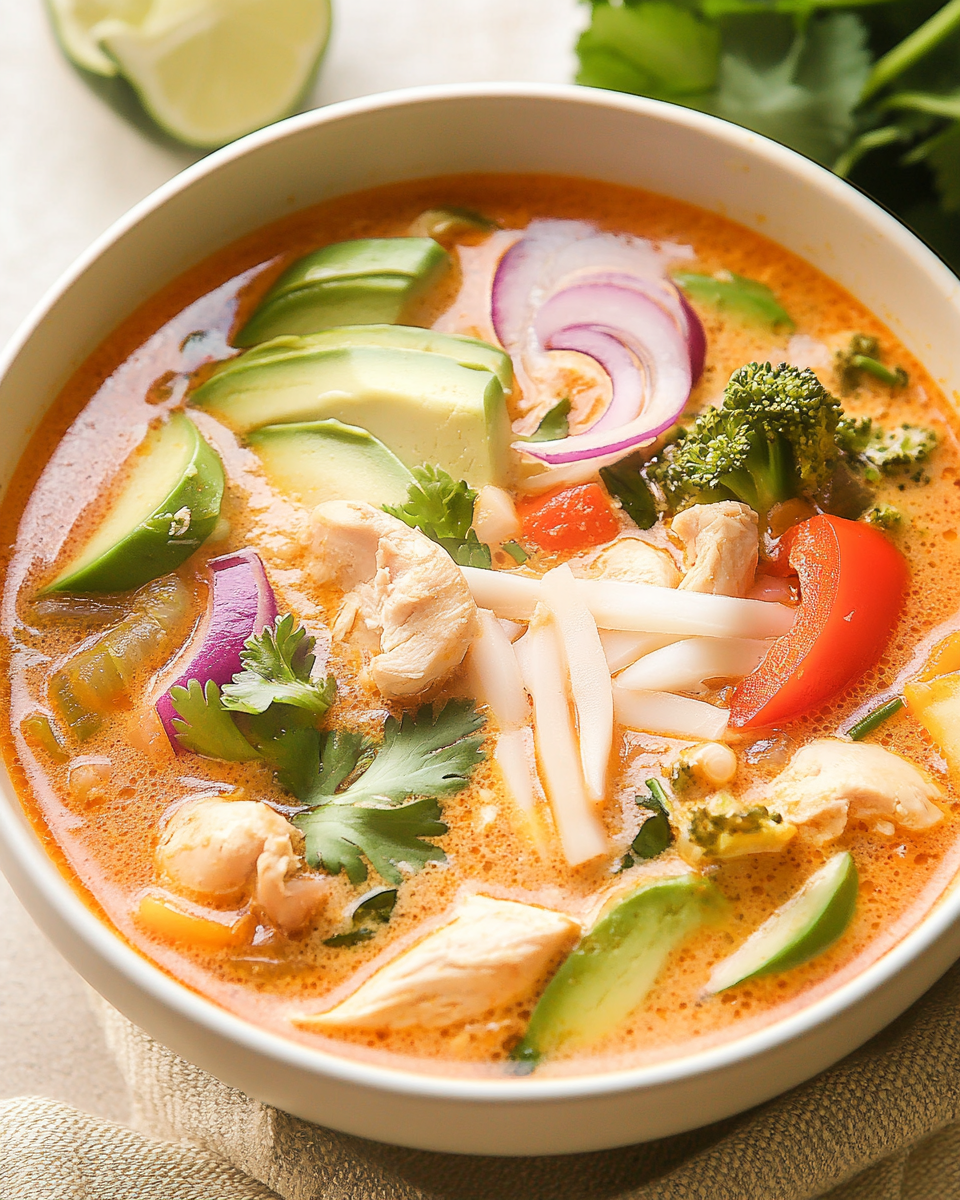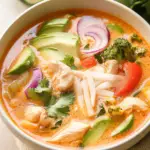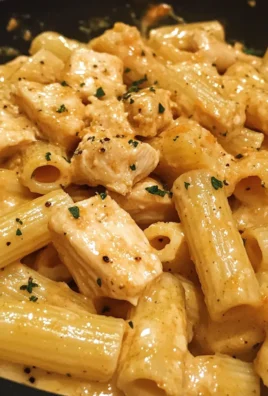Thai Coconut Curry Chicken Soup is a rich and comforting one-pot dish infused with the bold, vibrant flavors of Thai cuisine. It’s warm, creamy, a little spicy, and packed with nutrient-dense vegetables and tender chicken. What sets this soup apart is its versatility and health-friendly ingredients—it’s completely dairy free, gluten free, and Whole30 compliant, making it suitable for a wide range of diets.

This soup is ideal for cozy weeknight dinners, meal prep, or when you’re craving something nourishing yet exciting. The use of red curry paste, fresh aromatics, and creamy coconut milk creates a perfect balance of spice, richness, and tang. Whether you serve it on its own or with a side, it’s a hearty, satisfying meal that can stand on its own.
Why You’ll Love This Recipe
- Completely dairy free, gluten free, and paleo-friendly
- Made in one pot for easy cleanup
- Ready in under 45 minutes
- Packed with lean protein and fresh vegetables
- Customizable with your favorite Thai ingredients
This soup delivers restaurant-quality flavor without the fuss. It’s also great for meal planning since it stores well and reheats beautifully.
Preparation Phase
Essential Tools and Equipment
To create this soup with minimal stress and maximum flavor, gather the following kitchen tools:
- Large soup pot or Dutch oven
- Cutting board
- Sharp knife
- Measuring cups and spoons
- Wooden spoon or heat-resistant spatula
- Ladle
Importance of Each Tool
- Large pot or Dutch oven: Necessary for cooking all components evenly without overcrowding.
- Sharp knife: Ensures precise, uniform cutting of vegetables and chicken for even cooking.
- Wooden spoon or spatula: Helps stir aromatics and paste thoroughly to avoid burning and ensure even flavor distribution.
- Ladle: Makes serving cleaner and easier, especially when working with a rich broth.
Preparation Tips
- Use fresh ginger and garlic for the most intense flavor.
- Cut chicken into small, uniform pieces to ensure quick, even cooking.
- Slice vegetables evenly so they cook at the same rate.
- Blooming the curry paste (cooking it briefly in oil) is essential for unlocking its full flavor potential.
- Add lime juice at the end to preserve its brightness.
Ingredients
Base Ingredients
- 2 tablespoons avocado oil or toasted sesame oil
- ½ medium onion, thinly sliced or chopped
- 3 cloves garlic, chopped
- 1 teaspoon fresh ginger, grated or finely chopped
- ¼ cup red curry paste (or substitute green curry paste)
Vegetables
- 1 red bell pepper, thinly sliced
- 2 carrots, thinly sliced
- 1 medium zucchini, halved and sliced
- 2 cups broccoli florets
Liquids and Protein
- 4 cups low-sodium chicken broth
- 1 (13.5 oz) can full-fat coconut milk
- 3 tablespoons coconut aminos
- 1 pound chicken breast, cut into bite-sized pieces
- Juice of 1 lime
- 1 teaspoon salt (or to taste)
Optional Garnishes
- Fresh cilantro or basil
- Green onions, thinly sliced
- Chili oil
- Chopped cashews
- Lime wedges
Step-by-Step Instructions
- Sauté the aromatics
In a large soup pot, heat the oil over medium heat. Add the onion, garlic, and ginger. Cook for about 2 minutes until the onion is soft and fragrant. - Bloom the curry paste
Stir in the red curry paste and cook for 1 minute. This step deepens the flavor by activating the spices. - Cook the vegetables
Add the bell pepper, carrots, and zucchini. Stir to coat them with the curry mixture. Cook for 3 to 4 minutes, until they begin to soften. - Add the liquids
Pour in the chicken broth, coconut milk, and coconut aminos. Raise the heat to bring the soup to a gentle simmer. - Add chicken and broccoli
Stir in the chicken breast and broccoli florets. Let the soup simmer for 5 to 6 minutes, or until the chicken is fully cooked and the broccoli is just tender. - Finish with seasoning
Stir in the lime juice and season with salt to taste. Adjust the seasoning as needed. - Serve hot
Ladle the soup into bowls and top with your choice of garnishes. Serve with lime wedges on the side for added brightness.
Serving Suggestions
Thai Coconut Curry Chicken Soup is a complete meal on its own, but pairing it with the right side dishes can elevate it even further. Whether you’re looking for something light and refreshing or hearty and satisfying, here are some excellent serving ideas.
Light Pairings
If you want to keep the meal light while balancing the soup’s richness, consider the following options:
- Thai Cucumber Salad
A chilled cucumber salad dressed with rice vinegar, sesame oil, and a sprinkle of sesame seeds adds a refreshing contrast to the spicy, creamy soup. - Steamed Jasmine or Basmati Rice
A classic pairing that soaks up the flavorful broth beautifully. Rice makes the soup even more filling without adding dairy or gluten. - Cauliflower Rice
A low-carb, paleo, and Whole30-friendly option that maintains the Thai theme while keeping the meal nutrient-dense.
Hearty Complements
For those with a bigger appetite or serving guests, try these side dishes:
- Thai Lettuce Wraps
Filled with ground meat or tofu, herbs, and chopped vegetables, these wraps make a crunchy and savory companion. - Vegetable Spring Rolls
Served fresh or lightly pan-fried, spring rolls provide a mild contrast and great texture. - Grilled Pineapple Skewers
The sweetness of grilled pineapple helps balance the soup’s spiciness while adding depth to the meal. - Mango Sticky Rice (if not Whole30)
A popular Thai dessert that rounds off the meal with a sweet, coconut-infused note. While not Whole30-compliant, it’s a great treat when you’re not following dietary restrictions. - Chili Garlic Edamame
Lightly seasoned edamame pods are a protein-rich, snackable side that pairs well with bold Thai flavors.
Each of these options brings something unique to the table. Choose one or two based on your dietary preferences and time constraints.
Common Mistakes to Avoid
Getting the balance of flavors and textures right is key when preparing Thai Coconut Curry Chicken Soup. Below are the most common missteps and how to avoid them.
Using a Low-Quality Curry Paste
The curry paste is the flavor foundation. Choose a high-quality Thai brand such as Mae Ploy or Thai Kitchen. These provide authentic taste without overwhelming spice.
Adding Lime Juice Too Early
Citrus flavor fades when cooked too long. Always stir in lime juice at the very end to maintain its fresh, zesty brightness.
Overcooking the Chicken
Chicken breast can become dry and rubbery if overcooked. Cut it into small, even pieces and simmer gently. Avoid boiling.
Overcrowding the Pot
Too many ingredients at once can lower the temperature and prevent even cooking. Add vegetables in stages and keep the pot at a steady simmer.
Skipping the Curry Paste Blooming Step
Curry paste needs to cook in oil briefly to release its full range of spices. This step should never be skipped, as it unlocks the flavor depth that defines Thai cuisine.
Inconsistent Vegetable Sizes
Uniform slices ensure that all vegetables cook evenly. Overly thick or uneven pieces can remain undercooked or turn mushy.
How to Perfect the Recipe
Achieving the ideal flavor and consistency involves attention to detail and a few key techniques. These tips will help ensure your soup turns out just right every time.
- Layer Flavors Gradually
Start by sautéing aromatics before blooming the curry paste. Then add vegetables, broth, and finally chicken and broccoli. This layered approach builds depth in every spoonful. - Use Full-Fat Coconut Milk
Full-fat versions are creamier and add body to the soup. Light versions may water down the broth and reduce the satisfying texture. - Customize the Heat Level
Adjust the amount of curry paste based on your preference. Start with 2 tablespoons for a mild soup, and increase up to ¼ cup for more heat. - Add Fresh Herbs Just Before Serving
Cilantro, basil, or green onions should be added at the last minute to preserve their color and aroma. - Finish with Lime and Salt to Taste
Lime juice adds brightness, while a pinch of salt enhances the overall flavor. Always taste and adjust before serving. - Make It Your Own
Swap in shrimp or tofu instead of chicken, or add mushrooms, snow peas, or baby spinach for more veggie content.
Additional Tips for the Best Thai Coconut Curry Chicken Soup
Fine-tuning your soup doesn’t require a culinary degree—just a few smart strategies to enhance flavor, texture, and consistency. Whether you’re making this dish for the first time or refining your go-to method, these tips will help elevate the final result.
Use Fresh Ingredients When Possible
Fresh garlic, ginger, lime, and herbs make a noticeable difference. While dried spices and bottled lime juice can be used in a pinch, fresh ingredients deliver brighter, more vibrant flavors.
Don’t Skip the Garnishes
Garnishes like fresh cilantro, green onions, chopped cashews, and chili oil aren’t just for looks. They add texture, crunch, and extra layers of flavor. Choose one or combine several for a more dynamic bowl.
Adjust Thickness to Preference
If you prefer a thinner soup, add a splash of broth or water toward the end. For a thicker, creamier version, simmer a little longer uncovered or use slightly less broth.
Enhance Umami if Desired
If not on Whole30, a small dash of fish sauce can deepen the umami profile. Be cautious, as a little goes a long way.
Make It a Full Meal
This soup contains protein, fat, and vegetables, but adding a side of rice or a soft-boiled egg can turn it into an even more complete and satisfying meal.
Storage and Reheating Instructions
Knowing how to store and reheat your Thai Coconut Curry Chicken Soup will keep it fresh and delicious for days. This makes it ideal for meal prep and leftovers.
Storing Leftovers
- Transfer any remaining soup to an airtight container once it has cooled to room temperature.
- Store in the refrigerator for up to 5 days.
- Avoid leaving the soup at room temperature for extended periods, as this can compromise both safety and flavor.
Freezing Instructions
- This soup freezes well due to the lack of dairy.
- Freeze in individual portions using freezer-safe containers or resealable bags.
- Label with the date and consume within 2 to 3 months.
- Note that some vegetables may soften slightly upon reheating, but the overall texture remains satisfying.
Reheating Guidelines
- Stovetop: Reheat over medium heat until warmed through. Stir occasionally to prevent sticking.
- Microwave: Place in a microwave-safe container. Cover loosely and heat in 1-minute intervals, stirring between each, until hot.
- If the soup has thickened in the fridge or freezer, add a small amount of broth or water while reheating.
Frequently Asked Questions
Can I make this soup vegetarian or vegan?
Yes. Replace the chicken with tofu or tempeh and use vegetable broth instead of chicken broth. Ensure your curry paste is vegan, as some contain shrimp paste.
Is this soup spicy?
The level of heat depends on the curry paste used. Red curry paste typically provides moderate spice. To reduce heat, use less paste or choose a milder variety. You can also add more coconut milk to mellow the flavor.
Can I use light coconut milk instead of full-fat?
Yes, but the texture will be less creamy and slightly thinner. Full-fat coconut milk creates a richer, more satisfying soup.
Is this recipe gluten free?
Yes, as written, it’s entirely gluten free. However, always check labels, especially for curry paste and coconut aminos, as formulations can vary.
Can I make this in advance?
Absolutely. In fact, the flavor often improves after a day in the fridge. Prepare the soup ahead of time and store in the refrigerator or freezer until needed.
What’s the best protein substitute for chicken?
Shrimp is an excellent alternative and cooks quickly. For a plant-based version, tofu or tempeh works well. Cook tofu separately and stir it in just before serving to retain its texture.
Conclusion
Thai Coconut Curry Chicken Soup is more than a quick, nourishing meal—it’s a flavor-forward experience that captures the essence of Thai cuisine in every spoonful. With bold aromatics, creamy coconut milk, vibrant vegetables, and lean protein, it’s a comforting and health-conscious option that fits a wide range of dietary needs.
This soup proves that healthy eating doesn’t mean sacrificing flavor. With simple, wholesome ingredients and flexible variations, it’s a dish you can enjoy all year round. Whether you’re cooking for yourself or serving a crowd, the result is always satisfying, balanced, and rich with Thai-inspired taste.
Add it to your weeknight dinner rotation, prepare it in batches for future meals, or impress guests with a restaurant-quality dish that comes together effortlessly. However you serve it, this dairy-free, gluten-free, Whole30-friendly soup is sure to become a go-to favorite.
Thai Coconut Curry Chicken Soup (Dairy Free)
Ingredients
- 2 tablespoons avocado oil or toasted sesame oil
- 1/2 medium onion thinly sliced or chopped
- 3 cloves garlic chopped
- 1 teaspoon fresh ginger grated or finely chopped
- 1/4 cup red curry paste or green curry paste
- 1 red bell pepper thinly sliced
- 2 carrots thinly sliced
- 1 medium zucchini halved lengthwise and sliced
- 4 cups chicken broth low sodium preferred
- 1 13.5 oz can full-fat coconut milk
- 3 tablespoons coconut aminos
- 1 pound chicken breast cut into bite-sized pieces
- 2 cups broccoli florets
- 1 teaspoon salt or to taste
- Juice of 1 lime
For Garnish (optional):
- Fresh cilantro or basil
- Red or green onions thinly sliced
- Chili oil
- Chopped cashews
- Extra lime wedges
Instructions
- Sauté aromatics: In a large soup pot, heat oil over medium heat. Add the onion, garlic, and ginger. Cook for about 2 minutes, stirring, until onions soften and garlic is fragrant.
- Add curry paste: Stir in the curry paste and cook for 1 minute, allowing it to bloom and coat the aromatics.
- Cook the veggies: Add bell pepper, carrots, and zucchini. Stir to coat in curry mixture and sauté for 3–4 minutes, until slightly softened.
- Add liquids: Pour in the chicken broth, coconut milk, and coconut aminos. Increase heat to medium-high and bring to a gentle simmer.
- Add chicken and broccoli: Stir in the chicken breast and broccoli florets. Simmer for 5–6 minutes, or until chicken is fully cooked and broccoli is bright green and tender.
- Season and finish: Stir in lime juice and salt to taste. Adjust seasoning as needed.




Leave a Comment